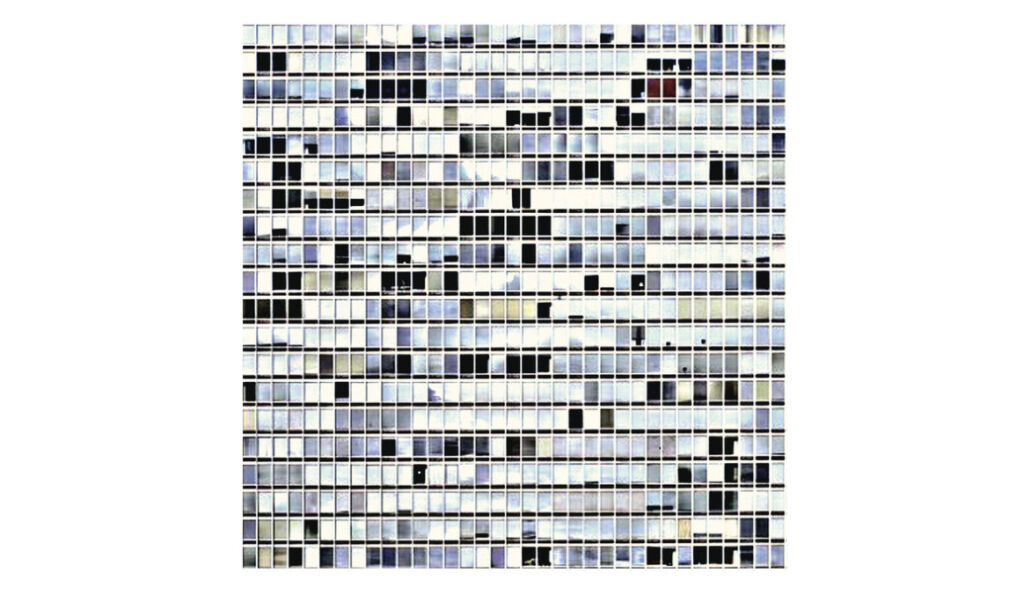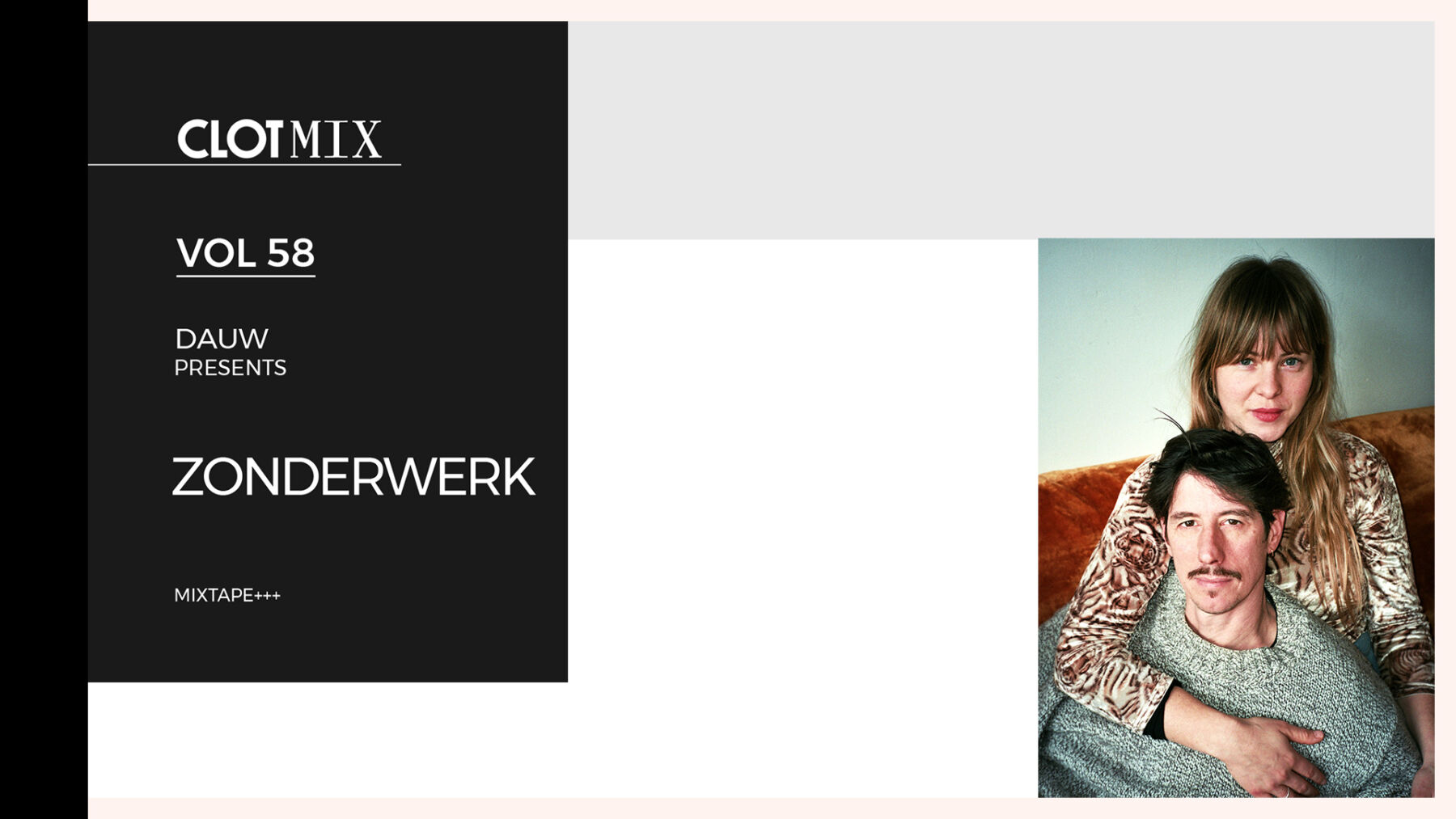Text by CLOT Magazine

The next mixtape comes from ZONDERWERK, who are a duo consisting of Linde Carrijn and Dijf Sanders. The artists started this project during the pandemic to explore their relationship as creative partners.
Carrijn has a background in acting but has recently been more focused on composing and performing original scores for theatre. Sanders is also a composer (and music gear enthusiast), with his work drawn from a wide array of non-Western music.
The duo explain that their artistic name means ‘’without work’, but it also comes from ‘bijzonder werk’, where bijzonder is particular and unique. Both artists like to work with images/paintings that are ‘bijzondere werken’, odd works, special and weird. The fact of working with images adds a particular approach to their creative process. As they mention, adding music and sound design to the work of art creates a new dimension and amplifies the beholder’s experience. It’s an extra layer, an alternative storyline outside the frame
ZONDERWERK have recently released their debut album babel, on the Ghent-based tape record label Dauw (which similarly has a central visual/graphic aspect to their outputs and ethos). The album materialises the duo’s conceptualisation for this project: babel is an exercise in translating images into sound. It was initially created for the eponymous theatre piece by architect and artist Steve Salembier. One of the biggest inspirations for the album was Michael Woolf’s photographs, which in turn also served as the basis for the original theatre piece. The use of grey and repetition is translated into looped harmonies and fine-grained drones that progressively open up like blooming ice flowers.
Using city-reminiscent musical elements, such as bells and metals, to create synthy lines, tape loops, and droney. There are details of fourth-world sounds that delicately populate the different tracks; small oases where to breathe away the man-made concrete jungle that is both inhospitable and endlessly awe-inducing.
The mixtape they have prepared for us is full of compositions they are inspired by: Some we love because of the choice of the gear, some of them we love because of the emotionality, and some of them we love because of the memory of a moment we listened to it together.
Behind ZONDERWERK are Linde Carrijn and Dijf Sanders. You started this project during the pandemic to explore the relationship as creative partners. How has this collaboration changed your creative process? And how do your individual background complement each other?
During the pandemic, there was plenty of time. There was time to do nothing. Time to do something. Time to discover without a goal. Time to wander around and experiment with a peaceful mind. There was time to experiment with slow gear and methods like tape and sampling.
The idea of making soundtracks on graphic novels and paintings already existed, so now there was time to expand this idea. Most of the time, we just sat, watched an image, talked about what it looked like, what feeling it evoked, what sound it would initiate,… and then we just playfully tried things. It was a winter evening, and 10 centimetres of snow were above our roof. I remember us setting up a microphone in our living room, just beneath the roof. We pressed record and walked on the roof, on the terrace, to collect these crunchy snow sounds.
Without thinking about a potential live show or album, or audience. It was our time together.
Dijf his interest in gear is huge. He rather read a manual of a machine he would love to have than watch television. Gear with limitations is gear with possibilities. He multiplies the sounds with the discoveries of the limits of the gear. Linde works in theatre and is interested in searching multiple layers between media and platforms. How to translate physicality into sound? How to make a contrast between sound and content? How to make different media work together enriches each other.
With ZONDERWERK, this translation of image to sound gives the image extra layers to communicate. Through image, gear, textures and harmonies, we build a universe that is an intuitive composition.
babel is your debut album, an ambitious exercise in translating images into sound. According to your statement, babel was first created for the eponymous theatre piece by architect and artist Steve Salembier. What is the intellectual process behind its inception?
For Salembier, Babel is the city that contains all other cities, where the temporary has become a permanent state of being – where travelling and being on the move is a destination itself and where subway lines, escalators and elevators transform ordinary movements into rituals. Salembier dissects the 21st-century metropolis as an “inadequate biotope” in which the tension between the megalomania of the urban landscape and the downscaling of the intimate world of individuals is magnified.
Using scale models, photography, video and projection, he portrays how the relationships between individuals and their living environments are fundamentally changed and how we are constantly subject to extreme conditions.
And what were you exploring at a more technical/compositional level?
This was our first project together after our experiment with paintings during Covid. We tried to collect and create a library of sounds and compositions in our working studio. For babel, it turned out to be the experiment of “how can we use one single sound for everything”. One note on the beam harp (self-made instrument) was pretty much it. We pitched, warped, sampled, resampled, detuned and sometimes added other layers and textures…
How did you translate/capture the atmosphere of Salembier’s modern metropolis into sound?
Some of Salembier’s maquettes are a pattern, repetitions and variations of an idea. The maquettes are different, but you see they are connected. We tried to do the same with the score. You feel that they are connected, but they sound different.
In babel we can find a beam harp, a self-made metal instrument with piano strings, reel-to-reel tape recorders, field recordings and violin. What are your main sound/instrument inspirations for your productions these days?
It depends on the project. We will make an audio installation for an expo on World War 2. We will use recordings of radio speeches of that period in combination with violin. We will also translate morse-code into something poetic. Next year we will again create some soundtracks for paintings, and definitely, we will use old samplers again; what a creative toolbox! We work in service of and in combination with other work, which often defines our signature.
What is your relationship with technology nowadays? And how do you cope with technology (screen/digital) overload?
Everything is going so fast. We are so not ready for it. As an artist, you must be “there” on the socials. But that is a full-time job. We don’t have enough time for that. Also, it is really difficult to disappear and climb into the shell of creativity because there is a lot of distraction.






